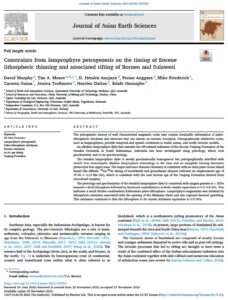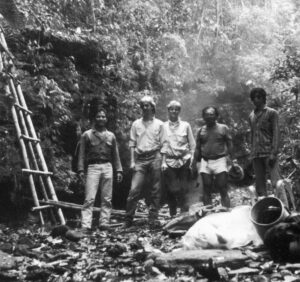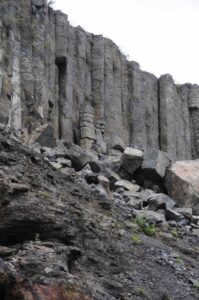 How the newly published paper “Constraints from lamprophyre petrogenesis on the timing of Eocene lithospheric thinning and associated rifting of Borneo and Sulawesi” (Murphy et al., 2024) came to be has an interesting history. Well, to me anyway.
How the newly published paper “Constraints from lamprophyre petrogenesis on the timing of Eocene lithospheric thinning and associated rifting of Borneo and Sulawesi” (Murphy et al., 2024) came to be has an interesting history. Well, to me anyway.
If we take the Way Back Machine* to the mid-1980s, when I was doing my PhD field work in the Eocene age Tanjung Formation of southeastern Kalimantan (Borneo), Indonesia we noticed some strange units that didn’t quite look purely sedimentary. Then we noticed some definitely not sedimentary units that cross cut the coal beds we were studying. These volcanic units heated up the organic material increasing the rank of the coal. It wasn’t the major focus of our work so we noted it (Moore, 1990) and then kept the focus on the formation of the sediments and paleopeat (my PhD supervisor, Prof John Ferm, was nothing if not focused).
Then, a few years later (1991), I was travelling through the same area and giving some workshops in the field to the miners when they showed me some interesting core. As the engineers were about to push the whole lot down the side of the hill (we screamed in dismay) we quickly logged it. Those sections resulted in some fascinating cross sections seen in the current paper. During our logging we noticed volcanogenic sediments as well as dark mafic units that were perhaps basalt.
These units appeared to be contemporaneous with the sediments, something that had not been noted anywhere before in this part of Kalimantan. So we took samples where we could and later did some geochemical, thin section and XRD work. But in the end, there was not enough information to make a publication and so I thought “someone else will address this…surely”.
Skipping ahead to 2011, and Duncan Witts publishes his work (Witts et al., 2011, 2012) on the Tanjung Formation on the western side of the Meratus Mountains. ‘Great!’, I thought, finally some interest in the Eocene Tanjung Formation. There had already been lots published on the Miocene and the Kutai Basin to the north (think Robert Hall’s group) but really nothing at all on the Eocene rift basins to the south. I always found this curious as there are abundant mines there and, really as any working geologist knows, the best data on the actual rock types lie within the mines.
Duncan’s publication sparked my interest again in the Tanjung Formation and I searched for a publication that addressed these mafic units we had seen years before. To my surprise there was nothing in the literature (or virtually nothing – I later found some articles in local conferences by mining personnel). Again, this was curious since these units were known and well delineated by the numerous mines in the area.
So, in 2017, Mike Friederich and I decided to travel back to SE Kalimantan and sample. With the wonderful support from our colleagues at the University of Gadjah Mada (Profs Hendra Amijaya and Ferian Anggara) as well as P.T. Artumin, the local mining company, we delineated the distribution of mafic material, some with beautiful columnar jointing, in the eastern part of Senekin Peninsula, South Kalimantan (Moore et al., 2020).
I’m no igneous petrographer and so I enlisted the help of my fellow Queensland University of Technology colleagues at the School of Earth and Atmospheric Sciences (Dr David Murphy and Jess Trofimovs) to take the research further using freshly cored samples of the mafic units. These yielded superb samples, good enough to for all manner of analyses including age dating.
When we had first published the field work (Moore et al. 2020) Duncan Witts had suggested using the Ar/Ar dating technique for mafic material. The fresh core allowed this and although it is a long preparation process we finally got an excellent date of 37.45 ±0.1 Ma. This date nicely supported the dates for the Tanjung Formation using microfossils.
So, here we are, some 38 yrs after these mafic units first came into my view. We now have a PhD student, Edafe Ominigbo, taking over the research under the direction of David Murphy. There is a lot more to learn and no doubt more questions will come up that will surprise. Maybe, even, Mr Ominigbo will see something just off the focus of his research that he may follow up on decades later; perhaps a bit out of time but never out of place.
Moore, T.A., 1990. An alternative method for sampling and petrographically characterizing an Eocene coal bed, southeast Kalimantan, Indonesia. PhD dissertation, University of Kentucky Lexington, 240 pp.
Moore, T.A., Friederich, M.C., Trofimovs, J., Anggara, F., Amijaya, D.H., 2020. Syn-sedimentary mafic volcanics in the coal-bearing Tanjung Formation (Eocene), Senakin Peninsula, South Kalimantan (Borneo), Indonesia. Indonesian Journal on Geoscience 7, 65-85, http://jgi.bgl.esdm.go.id/index.php/IJOG/article/view/653/302.
Murphy, D., Moore, T.A., Amijaya, D.H., Anggara, F., Friederich, M.C., Gaina, C., Trofimovs, J., Dalton, H., Ominigbo, E., 2024. Constraints from lamprophyre petrogenesis on the timing of Eocene lithospheric thinning and associated rifting of Borneo and Sulawesi. Journal Asian Earth Sciences 260, 105952, https://doi.org/10.1016/j.jseaes.2023.105952.
Witts, D., Hall, R., Morley, R., BouDagher-Fadel, M.K., 2011. Stratigraphy and sediment provenance, Barito Basin, Southeast Kalimantan, Proceedings, Indonesian Petroleum Association Thirty-Fifth Annual Convention & Exhibition. Indonesian Petroleum Association, Paper IPA11-G-054, Jakarta, Indonesia, 18 pp.
Witts, D., Hall, R., Nichols, G., Morley, R., 2012. A new depositional and provenance model for the Tanjung Formation, Barito Basin, SE Kalimantan, Indonesia. Journal of Asian Earth Sciences 56, 77-104.
*as in Mr Peabody and Sherman’s ‘Wayback machine’





Comments are closed.